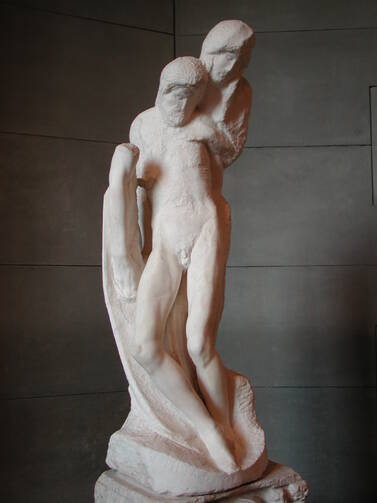MILAN—We call this Friday "good," a holy irony, a childish whistle past the graveyard, or maybe a deep insight. Here in Italy and in many other places, it is "Holy" Friday. That needs no explanation.
One place here in Milan that allows access to the holy is not a church at all but the Sforza Castle, the seat of power for centuries with massive walls and towers and today's remnants of the once surrounding moats, now dry and home to stray cats. The holy appears in a museum with centuries' worth of Christian art depicting scenes from the Bible and images of saints, the local hero Ambrose prominent among them. Our ancestors in faith have given us testimony of their faith in stone. Set off nearby in its own small part of the castle is a Pietà by Michelangelo, and it is not hard to gaze at this sculpture and find holy space indeed.
Michelangelo's best known Pietà is in St. Peter's in Rome. Here the figure of Mary sits sad but serene with the corpse of Jesus in her lap, reminiscent of a Madonna and Child. Another, in Florence, has a figure—usually thought to be Nicodemus—supporting Mary, who holds Jesus. A fourth figure, thought to be Mary Magdalene, stands to their right.
This Pietà in Milan (the Rondanini Pietà) is very different. Mary stands, struggling to hold up the body of Jesus. His body is taller than hers, and the distribution of weight seems quite impossible. But physics is not the point here. The point is loss, devastation and fidelity. The apostles, those chosen to share Jesus' mission, are gone; they are hiding somewhere. Other followers have fled. Only Mary remains.
One compelling aspect of the third Pietà is how unfinished it is. It is clearly a work in progress. Experts propose that Michelangelo was reworking this block of marble from an earlier idea he did not finish. This would account for a shaped and polished but unattached arm to the left of the figures of Jesus and Mary. Jesus' legs are also polished. The rest is in very rough cut.
Of the rest Mary's face is perhaps the most complete, but it is still far from done. She struggles with the weight of her son's body and with the weight of all that was done to him. But still she shows a calm serenity. She is doing what was given to her to do, even with no one there to share her mission.
Other portions of the sculpture show only the roughest hints of what the artist sees. Much of the piece is still gouges and scrapes of chisel strokes. Still, the artist's vision is emerging in the stone.
A recent book gives insight into what is happening here. It is a series of meditations that follow the Way of the Cross based on a modern bronze sculpture by the artist Werner Klenk. Reflecting on the eleventh station, where Jesus is crucified, the author Bert Daelemans sees here the Transfiguration of Golgatha, or the disfiguration, in which we find it very hard to see God. "Why is it so easy to disfigure the humanity we all share?" the author asks. He then says that he sees this dis figuration "in the refugees, the prisoners, the sick." He sees them on street corners and in gutters. He sees them on "the threshold between you and me." (The book is An Ignatian Journey of the Cross, Liturgical Press, 2015.)
In the stone of the Pietà we see Jesus disfigured. He is rough cut and unpolished. He is the people of our world. He is each one of us. Like us, these sculpted figures are unfinished. As we see them, we see ourselves in outline, in hints, in failures and mistakes and sins. A lot of chisel strokes mark each of us, but these slashes can be the beginnings of the new creation ready for detail work and final polish.
Despite all the suffering and loss, this Friday is God's working in us. And it really is good!








